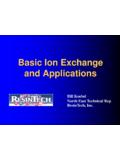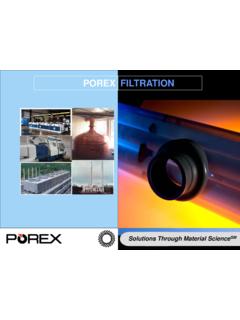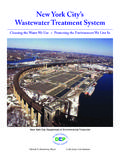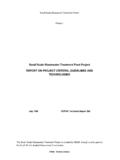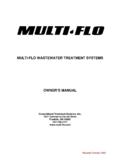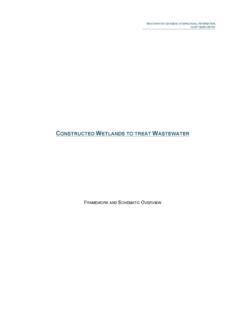Transcription of WASTEWATER LAGOONS TRAINING AND …
1 WASTEWATER LAGOONS TRAINING AND TROUBLESHOOTINGTYPES OF LAGOONS AEROBIC ANAEROBIC FACULTATIVEAEROBIC LAGOONS that have dissolved oxygen distributed throughout their contents all the time. Require additional source of oxygen to supplement the minimal amount that can be diffused from the atmosphere at the water surface. The additional source of oxygen may be supplied by algae, during sunlight hours, by mechanical agitation of the surface, or by bubbling air provided by compressors through the LAGOONS that are without any dissolved oxygen throughout their entire depth. Treatment depends on fermentation of the sludge at the lagoon bottom. This process can be quite odorous under certain conditions. But, is highly efficient in destroying organic wastes. Anaerobic LAGOONS are mainly used for processing industrial wastes, although some domestic-waste LAGOONS will become anaerobic when they are badly LAGOONS are the most common type in current use.
2 The upper portion of these LAGOONS is aerobic, while the bottom layer is anaerobic. Algae or surface type mechanical aerators supply the oxygen to the upper ARE DESIGNED TO: CONTINUOUS DISCHARGE CONTROLLED DISCHARGE NO DISCHARGECONTINUOUS DISCHARGE USUALLY DISINFECT THE PLANT EFFLUENT IN ORDER TO DESTROY THE PATHOGENIC (DISEASE CAUSING) ORGANISMSCONTROLLED DISCHARGE WASTEWATER IS HELD FOR LONG PERIODS OF TIME BEFORE DISCHARGING. DISCHARGE PERIODS ARE USUALLY TWICE A YEAR SPRING - SHORTLY AFTER THE ICE BREAKS UP FALL - AFTER THE FIRST FROSTBASED ON TWO FACTORS CONDITION OF RECEIVING STREAM CONDITION OF lagoon CONTENTSNO DISCHARGE LAGOONS EVAPORTION RATE AND/OR GROUND PERCOLATION EQUALS OR EXCEEDS THE INFLUENT RATEBIOCHEMISTRY OF A lagoon The life cycle of a lagoon depends on a number of factors. Organisms, including algae, bacteria and protozoa depend on levels of dissolved oxygen nutrients and each other for Microscopic plants present in LAGOONS .
3 Green algae that belong to chlorella family are most common and stay near the surface of water. Algae depend on nitrogen, phosphorous, CO2 and sunlight to carry on photosynthesis oxygen is a by product of Microscopic one celled organisms responsible for the majority of WASTEWATER stabilization. Bacteria present in a lagoon operate either aerobically, anaerobically or in a facultative BACTERIA Utilize dissolved oxygen during its life cycle to breakdown organic material. As these bacteria multiply and break down carbonaceous - BOD flocculation occurs and the cells settle. Byproducts of organic material breakdown are nutrients (N&P), CO2, and BACTERIA These bacteria operate with or without oxygen. Facultative bacteria operate in the middle portion of a lagoon and use chemically bound oxygen for life activity. NO3, SO4 are utilized in respiration for life BACTERIA Thrive in conditions where dissolved oxygen is absent.
4 In a lagoon , these bacteria degrade organics in the sludge layer. Sludge is formed by a combination of settable solids, flocculated bacteria from aerobic zone and dying algae that drops to bottom. H2S, CH4, CO2, NH3 are major byproducts from anaerobic Indicate levels at which wastes have been stabilized. Protozoa feed on bacteria and algae and keep those numbers in check. Lig. Paramecium, vorticella, ciliates, daphnia. All of the above mentioned work together to stabilize WASTEWATER . LAGOONS are the most natural form of treatment in the WASTEWATER industry. However, an imbalance in nutrients or abnormal loadings can inhibit natural action or encourage one group of organisms to dominate leading to other problemsNutrient balance for bacteria. Optimum ration of carbon, nitrogen, phosphorous For every 100 mg/l of carbonaceous BOD There should be 5 mg/l of NH3-N 1 mg/l of P3 To alleviate abnormal loadings or inhibitory substances, a growing part of lagoon treatment is utilizing bioaugmentation to break up sludge blankets and improve BOD, SS & NH3-N CONSIDERATIONSCAPABILITY TO MOVE WATER AROUND WITHIN THE SYSTEM Pre-mixing lagoon contents with influent to supply oxygen to raw WASTEWATER Portable pumps or pond recirculationMULTIPLE INLETS AND OUTLETS IMPROVES lagoon CIRCULATIONINTER- lagoon TRANSFER PIPES WITH VALVES OR GATES PERMITS INDIVIDUAL lagoon LEVEL OPERATE AT OPTIMUM lagoon LEVEL Example: Primary cell operates well at 8 foot water depth.
5 Final cell operates better at 3 foot water STRUCTURE PERMITS CONTROL OF lagoon DEPTHS CONTROL OF DISCHARGE RATEODOR CONTROL RESULT OF OVER LOADING LONG PERIODS OF CLOUDY WEATHER POOR lagoon CIRCULATION INDUSTRIAL WASTES ICE MELTODOR SOLUTIONS Run system in parallel to reduce loading Apply chemicals: Bacteria NitraidINSTALL SUPPLEMENTAY AERATIONRECIRCULATE lagoon EFFLUENT TO lagoon INFLUENTELIMINATE SEPTIC OF HIGH-STRENGTH INDUSTRIAL WASTESANIMAL CONTROL BURROWING ANIMALS: CAUSE DIKE ERROSION REMOVE FOOD SUPPL: CATTAILS, BURR REED MUSKRATES: RAISE AND LOWER lagoon (6-8 INCHES) OVER SEVERAL WEEKS SO AS TO FLOOD TUNNEL AND EXPOSE TUNNEL CHECK WITH GAME COMMISSION ABOUT APPROVAL METHODS, SUCH AS LIVE TRAPPINGANIMAL CONTROL (cont.) GEESE: CAUSE HIGH FECAL COUNTS IN EFFLUENT, AND POSSIBLE AMMONIA INCREASE?
6 Dog has best result Chicken wire on banks Blanks from shot gun Fox?ANIMAL CONTROL (cont.) TURTLES: Can burrow up to two feet in bottom of lagoon Trap and release in nearby streamCONTROL DIKE VEGETATION HIGH WEEDS PROMOTE ANIMAL NESTING PLACES FOR ANIMALS CAN CAUSE WEAKENING OF THE DIKE UNSIGHLTLY APPEARANCE REDUCES WIND ACTIONDIKE VEGETATION CONTROL SOLUTIONS MOWING: BEST METHOD SPRAY WITH APPROVED WEED CONTROL CHEMICALS PULL WEEDS BY HAND GRAZING (MAY INCREASE FECAL COLIFORM EFFLUENT LOWER POND LEVEL AND BURN OFFSCUM CONTROL CAUSES Pond bottom is turning over with sludge floating to the surface Poor circulation and wind action High amounts of grease and oil in influentSCUM CONTROL (cont.) SOLUTIONS Break up scum with high pressure hoses, pumps, fire truck. Scum usually sinks once broken up.)
7 Remaining scum should be removed and buried or hauled to AND MAINTENANCE GOALS FOR LAGOONS1 Meet NPDES discharge levels2 Discharge when it has the best quality with least effect on receiving Primary cells should have a deep green sparkling color (high )4 Secondary or final cells high in Wave action on surface when wind is blowingOPERATION AND MAINTENANCE GOALS FOR LAGOONS6 No weeds growing in water or on banks7 Dikes are well seeded above water line and grass is kept mowed8 Erosion is controlled by riprap9 Inlet and outlet structures are kept clean of debris, grease, scum, 0 Mechanical equipment is well maintained1 1 A schedule for getting things doneOPERATION CONSIDERATIONS FOR AERATED LAGOONS Maintain a minimum of 1 mg/l DO Aerators should produce good turbulence and a light amount of froth Monitor DO at aerated cell outlet daily Keep large debris out of lagoon that will damage aeratorsOPERATION CONSIDERATIONS FOR AERATED LAGOONS For diffused air systems that use blowers.
8 Check blower daily Visually inspect aeration pattern for dead spots Measure DO at several points weekly in the lagoon and adjust to maintain even distribution Periodic maintenance must be performed, such as lubrication, adjustment and replacement. Make a checklist of maintenance tasks frequency from the manufacturer s AND PREVENTATIVE MAINTENANCE PLANT SURVEY: Drive around perimeters of LAGOONS taking notes of the following conditions: Daily: Any buildup of scum on pond surface and discharge outlet boxes. Daily: Sings of burrowing animals Daily: Anaerobic conditions. Noted by odor and black color Daily: Water grown weedsOPERATION AND PREVENTATIVE MAINTENANCE cont. Daily: Evidence of dike erosion Daily: Dike leakage Daily: Fence damage As needed: Ice buildup in winter Daily: Evidence of short circuitingOPERATION AND PREVENTIVE MAINTENANCE (cont.)
9 Mechanical Equipment: Check mechanical equipment and perform scheduled preventive maintenance on the following pieces of equipment according to the manufacturer s StationsA . Daily:B . Daily:C . Weekly:D . Daily:E. Weekly:F. Per Manufacturer:Remove debrisCheck pump operationRun emergency generatorLog run timesClean floats, bubblers, or other control devisesLubricateComminuting DevicesA . Weekly:B . Per ManufacturerCheck cuttersLubricateAeratorsA . Daily:B . MonthlyC . Per ManufacturerRecord run timesCheck AmperageLubricateChlorinatorsA . Daily:B . As neededCheck feed rateChange Cylinders (two people)Flow Measuring DeviceA . Daily:B . 3 Months Check and clean floats, accuracyValve and gatesA . Daily:B . Monthly: Check to see if set correctlyOpen and close to be sure they operateBREAK TIME!!
